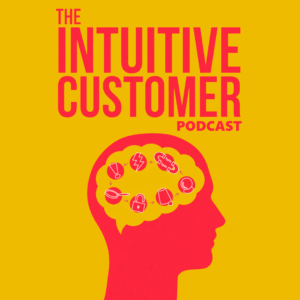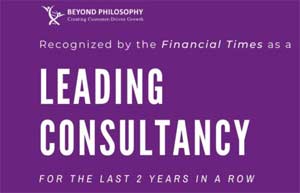I talk a lot about how people are irrational and have presented evidence for it. Most people can get on board with the idea that we are not robots that are purely rational.
Some people do push back on the idea that people are not rational. Typically, they are more rational-types. These non-believers throw up their hands and say, “Well, if we are all just mindless animals, are we going to treat people like dogs?”
We aren’t going to treat people like dogs. We are, however, going to figure out how they make decisions so we can design a Customer Experience that works with them during the process.
On our recent podcast, we discussed our rational and irrational tendencies as customers, a psychological concept that addresses why we are the way we are, and what you can do about it in your Customer Experience.
The Two-System Model of Thinking
When I bought my Lincoln Navigator, I created a detailed spreadsheet. I included the technical specifications, pricing for the lease and buying options, and loads of other details. I also compared the car with different makes and models, quite thoroughly.
However, if I’m being honest, I knew in the back of my mind I was going to buy the Navigator anyway, and I was just looking for an excuse to do so.
This situation is the classic bit about the intuitive and the rational mind. Your intuitive mind would go buy the car you want. The rational mind says you need to look into this in much greater detail because it’s an important decision.
The two-system model is the idea that people have a rational and intuitive way of thinking. Rational thinking is slow and deliberate, and irrational thinking is fast and instinctual. The two systems sometimes work together with their different approaches for making decisions. Other times they operate independently of each other.
However, the concept of the two-system model is relatively new by academic standards. There are older theories that address why we are the way we are when making decisions.
Rationality with Constraints
An older model about how we make decisions was developed by psychologist and economics professor Herbert Simon in the 60s. Simon was a genius in more than one field, and he won a Nobel Prize in Economics. He was also one of the first computer science professors and developed a lot of the theories on which modern computing is based. In short, he made significant contributions in a lot of different areas.
He developed the idea of Bounded Rationality, one of the most significant concepts in modern behavioral science. Simon says (Yes, I went there) when we say people aren’t rational, that doesn’t mean the opposite, that we are savages.
People are rational but not infinitely logical. They are rational within constraints.
The constraints are not surprising. We have limited memory, for example. We also have a limited attention span and energy for thinking. We also often have limited information, as well as limited abilities to forecast the future. If we were strictly rational, none of these limits would apply.
From a layman’s perspective, Simon says people are not computers. They don’t make rational decisions only, but they also don’t just make random decisions. However, Simon says there are constraints around the rationality you use for the choices you make.
For example, let’s say you hear about a special offer from one of your favorite retailers only two hours before it expires. However, when you are looking at the data available on the proposal, which is limited, your boss calls you into the office. All of those details of the situation in which you are making a buying decision are constraints, e.g., special offer expiring soon, limited data and the pressure of getting back to work. Simon says (last time, I promise) you are now making a decision within those constraints whether you like it or not.
Enter the Heuristics
So, we have limitations and constraints, but we still want to make a decision our rational mind would respect, we develop these shortcuts called heuristics. Heuristics are decision shortcuts we use that approximate rational decision making but are faster and easier. These efficient shortcuts are generally fine and get us pretty good decision outcomes.
Simon was one of the early champions of the idea of decision-making heuristics as a way of understanding human decision making. One of the most enduring heuristics was something called “satisficing,” which is a combination of the words “satisfy” and “suffice.” Satisficing is not attempting the best possible outcome but trying to get the first outcome that’s good enough.
It doesn’t mean the outcome is excellent or indicate that you’re going to stand out from the pack. It has reached the bar of acceptability.
Satisficing is not optimal decision making. If you use a satisficing strategy and happen upon the best option for you, then you are fortunate.
If you understand that your customers make decisions sometimes using satisficing, you can improve your Customer Experience. The secret is understanding the elements of that bounded rationality. It could be the time and effort involved, the price or how quickly they need the product or service.
However, there are also emotional things. It could be how much poor service your customers are willing to accept before they say something or leave. It could be the reputation of the brand. It could be the status it affords the customer.
A few years ago, we consulted a hospital system that wanted to improve the patient experience. Patients said they wanted the doctor to spend more time with them. However, when you looked into it, what was driving value was whether the doctor was listening to the patient.
From a bounded-rationality perspective, the time the doctor spends with you is a heuristic. You care about the quality of the medical service that you’re getting. But how can you possibly evaluate that? You’re bounded in your understanding. Instead, you use a heuristic which is, “If the doctor is spending a lot of time with me then he or she must be giving me quality care.”
What Does Bounded Rationality Mean to Your Customer Experience?
When you are designing a Customer Experience strategy, you need to consider the constraints your customers are feeling. They can be physical, like feeling tired or running out of time, or they can be rational, like price or delivery time. They can also be emotional, like wanting a particular brand, or hidden, like wanting to be heard by a medical professional. If you know these things, you can manage and design your experience to allow for those boundaries.
People are going to be rational. They are going to try to maximize their utility. However, they are going to go about it in less than rational ways driven by bounded-rationality. They will choose the best option that they can. Your job is to make sure that option is yours.
If you want to benchmark your organization’s performance in the new world of behavioral economics against other companies, take our short questionnaire. Once you submit, we compare your answers against what we know about the market and send you a free personalized report about where your organization is today.
 Hear the rest of the conversation on “How Customers Make Decisions in a World of Constraints” on The Intuitive Customer Podcast. These informative podcasts are designed to expand on the psychological ideas behind understanding customer behavior. To listen in, please click here.
Hear the rest of the conversation on “How Customers Make Decisions in a World of Constraints” on The Intuitive Customer Podcast. These informative podcasts are designed to expand on the psychological ideas behind understanding customer behavior. To listen in, please click here.
If you enjoyed this post, you might be interested in the following blogs and podcasts:
How Do Customers Decide If Their Experience is Good or Bad? [Podcast]
How We Make Decisions—Prospect Theory
Why Customers Make Strange Decisions
 Colin Shaw is the founder and CEO of Beyond Philosophy, one of the world’s leading Customer experience consultancy & training organizations. Colin is an international author of six bestselling books and an engaging keynote speaker.
Colin Shaw is the founder and CEO of Beyond Philosophy, one of the world’s leading Customer experience consultancy & training organizations. Colin is an international author of six bestselling books and an engaging keynote speaker.
Follow Colin Shaw on Twitter @ColinShaw_CX


